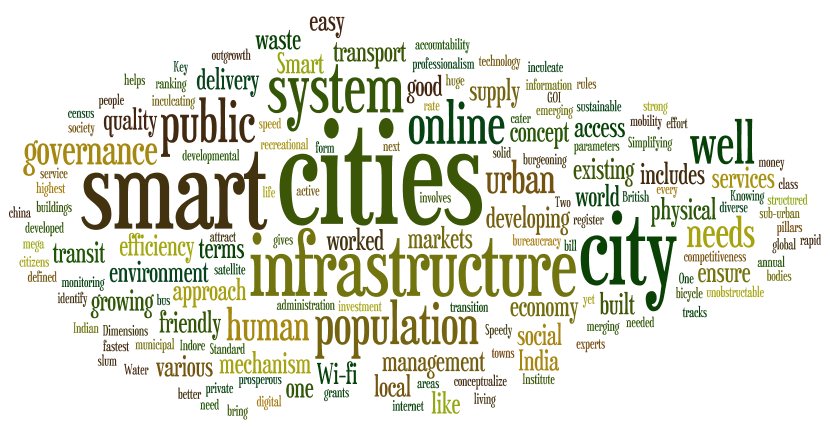Conceptualizing the Smart Indian cities
Indian is one of the fastest growing emerging markets of the world. Its burgeoning population stands second, next only to china. It has 31% of urban population growing at an annual rate of 3% and contributing 60% to its GDP. In 2011 census India has 53 mega cities, each with population more than a million. In order to cater such a huge population, adequate infrastructure is needed to our cities in the form of Smart cities.
What is the concept of Smart cities?
It means integrating several developmental dimensions and inculcating competitiveness and sustainability. According to British Standard Institute – a smart city is the effective integration of physical, digital, and human system in the built environment to deliver sustainable, prosperous, and inclusive future of its citizens. GOI defined smart cities as city able to attract investment, experts and professionals of diverse backgrounds. Good quality of infrastructure, public transport, easy delivery of public services, efficient administration and a friendly bureaucracy.
Knowing a city and ranking involves various parameters such as economy, people, society, governance, mobility, environment, and living condition.
Dimensions of smart cities
There are various approaches to conceptualize the smart cities. One, a techno-centered approach, with a strong emphasis on information and communication technology infrastructure as it is the keystone to smart city. Two – human centric approach emphasizing on social and human capital. Key pillars to ensure a good quality of life in a smart city is physical and social infrastructure. It includes unobstructable footpaths, bicycle tracks, roads, easy access to retail markets from every corner of city. It also includes primary schools, recreational centers, continuous supply of electricity and water, with high speed Wi-fi internet connectivity.
Public services
The Wi-fi system in major places gives access to online service delivery. From online FIR, elaborate tracking, online grievances redressal system, to online bill payment. Water supply, waste disposal along with infrastructure for solid waste management needs to be built. Speedy and comfortable public transport, metro rails and well structured bus rapid transit system like that of Ahmadabad and Indore. A well developed transit system helps to bring densification can yield economy of scale in terms of agglomeration of buildings.
Implementing and maintenance
The concept of smart cities could only be implemented with active participation of urban local bodies (ULB’s) to inculcate professionalism, better management, efficiency and citizen friendly accountability mechanism which ensure good governance and a smooth transition from government to governance. Simplifying rules and laws, regulating slum areas and unauthorized colonies, monitoring outgrowth and illegal construction is one such mechanism that needs to be worked upon. The urban planners need to identify the sub-urban location developing the satellite towns as smart cities as it is easier than developing an already existing city.
Financing the development through a well worked out public private partnership and merging the allowances and grants under the existing schemes like JNNURM. Also the local municipal bonds can be floated to raise money from the market. Such effort needs a political will as well as administrative efficiency of highest level. India is yet to register its cities in the global rankings in terms of world class infrastructure.


